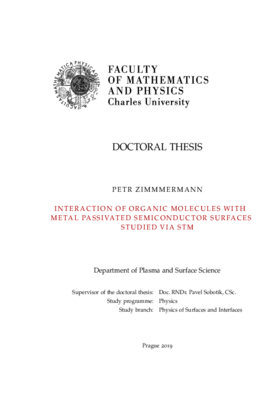Interaction of organic molecules with metal passivated semiconductor surfaces studied via STM
Studium interakce organických molekul na kovem pasivovaných površích křemíku pomocí STM
dizertační práce (OBHÁJENO)

Zobrazit/
Trvalý odkaz
http://hdl.handle.net/20.500.11956/110983Identifikátory
SIS: 85303
Kolekce
- Kvalifikační práce [11978]
Autor
Vedoucí práce
Oponent práce
Plšek, Jan
Šikola, Tomáš
Fakulta / součást
Matematicko-fyzikální fakulta
Obor
Fyzika povrchů a rozhraní
Katedra / ústav / klinika
Katedra fyziky povrchů a plazmatu
Datum obhajoby
26. 9. 2019
Nakladatel
Univerzita Karlova, Matematicko-fyzikální fakultaJazyk
Angličtina
Známka
Prospěl/a
Klíčová slova (česky)
adsorpce, fthalocyanin, CuPc, ethylen, ethen, křemík, Si(111), Si(001), povrch, cín, indium, defekty, STM, STS, PES, XPSKlíčová slova (anglicky)
adsorption, phthalocyanine, CuPc, ethylene, ethene, silicon, Si(111), Si(001), Si(100), surface, tin, indium, defects, STM, STS, PES, XPSNázev Studium interakce organických molekul na kovem pasivovaných površích křemíku pomocí STM Autor Petr Zimmermann Katedra / Ústav Katedra fyziky povrchů a plazmatu Vedoucí doktorské práce Doc. RNDr. Pavel Sobotík, CSc. Katedra fyziky povrchů a plazmatu Abstrakt Organické molekuly vykazují celou řadu optických, elektronických či chemických vlastností. Vhodnou integrací s křemíkem by tak mohly umožnit vznik zcela nových druhů zařízení. Řízená funkcionalizace křemíku organickými molekulami je však pro- blematická kvůli přítomnosti vysoce reaktivních vazeb na jeho površích. V této práci zkoumáme možnosti snížení reaktivity křemíkových povrchů pomocí ultratenkých vrs- tev kovových adsorbátů a s využitím řádkovací tunelové mikroskopie studujeme, jak s nimi interagují organické molekuly. V první části zkoumáme interakci ethylenu, malé nenasycené molekuly, s cínovými a indiovými 1D řetízky na Si(001) - 2 × 1. Tyto řetízky jsou tvořeny dimery, jež mají strukturu analogickou s křemíkovými dimery tvo- řící Si(001) - 2 × 1. Ukázalo se, že cínové řetízky jsou méně reaktivní než samotný Si(001) povrch a dále že absence π vazby v indiovém dimeru způsobuje, že indiové řetízky jsou pro etylen inertní. V druhé části pak zkoumáme interakci fthalocyaninu mědnatého (CuPc), malé makrocyklické heteroaromatické sloučeniny, na...
Title Interaction of Organic Molecules with Metal Passivated Silicon Surfaces Studied via STM Author Petr Zimmermann Department Department of Plasma and Surface Science Supervisor Doc. RNDr. Pavel Sobotík, CSc. Department of Plasma and Surface Science Abstract Organic molecules offer a wide range of optical, electronic or chemical properties. Coupling them to silicon could pave way to novel applications and devices, however, a controlled molecular functionalization of silicon remains challenging due to the presence of highly reactive dangling bonds on its surfaces. We attempt to decrease the reactivity of low index silicon surfaces with an ultra-thin layer of a metal adsorbates and study their interaction with organic molecules via scanning tunnelling microscopy. In the first part we investigate the interaction of ethylene, a small unsaturated molecule, with tin and indium 1D chains grown on Si(001) - 2 × 1. The chains consist of dimers structurally analogous to the dimers of the underlying Si(001) - 2 × 1 surface. Aided by photoelectron spectroscopy we find that the Sn chains are less reactive than the Si(001) surface and that the absence of a π dimer bond renders indium chains inert. In the second part we study the interaction of copper phthalocyanine, a small macrocyclic heteroaromatic compound, with the...
